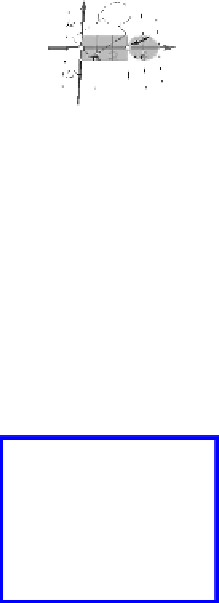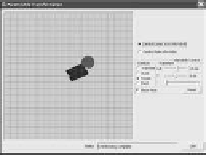Graphics Reference
In-Depth Information
call), then at label D, the
m
_
ArmXform
object concatenates
M
a
with the top of the
matrix stack and loads the concatenated result into the
WORLD
(
M
W
)matrix. The
concatenated top of stack
M
t
1
is
=
=
=
.
M
t
1
M
a
M
t
M
a
I
4
M
a
In this way, the top of the stack
M
t
1
is simply
M
a
and is loaded into the
M
W
matrix processor. As pointed out by Equation (11.1), all vertices
V
i
of triangles
that represent
R
a
0
and
C
p
0
will be transformed into
V
io
according to
V
io
=
V
i
M
W
M
V
M
P
(11.2)
=
V
i
M
a
M
V
M
P
.
The important lesson this tutorial demonstrates is that to control geometric objects
in computer graphics applications, we typically:
P
p
•
Do not
alter the basic geometry of the primitives (i.e., we do not change the
vertex positions of
R
a
0
or
C
p
0
).
P
a
C
p0
R
a0
•
Do
define a transformation operator to transform the defined geometric
primitives (i.e., we defined
m
_
ArmXform
(
M
a
) to transform
R
a
0
and
C
p
0
).
We can increase the complexity of the simple arm of Tutorial 11.1 by supporting
independent transformation control over the palm (
C
p
0
). As illustrated in Fig-
ure 11.3, we want the palm to be transformed with respect to the end of the arm,
or pivoted at the location
P
p
. Notice that, in addition to the independent trans-
formation of the palm, when we transform the arm by changing
M
a
, we would
expect the palm to follow
M
a
.
Figure 11.3.
Indepen-
dent transformation of the
palm.
Tutorial 11.2.
Project Name:
D3D
_
ParentChild
Library Support:
UWB
_
MFC
_
Lib1
UWB
_
D3D
_
Lib10
Tutorial 11.2. Independent Control of the Palm
•
Goal.
Work with two levels of transformations where the second level fol-
lows the transformation from the first level.
•
Approach.
Implement the arm/palm control as defined by Figure 11.3.
Figure 11.4 is a screenshot of running Tutorial 11.2. In this tutorial, by activating
the appropriate radio button, we can choose to interactively control the
entire
object (i.e.,
R
a
0
and
C
p
0
) or to independently transform only the palm object (i.e.,
C
p
0
). Listing 11.2 shows that the implementation of Tutorial 11.2 is similar to
that of Tutorial 11.1 with two important differences.
Figure 11.4.
Tutorial
11.2.









































Search WWH ::

Custom Search